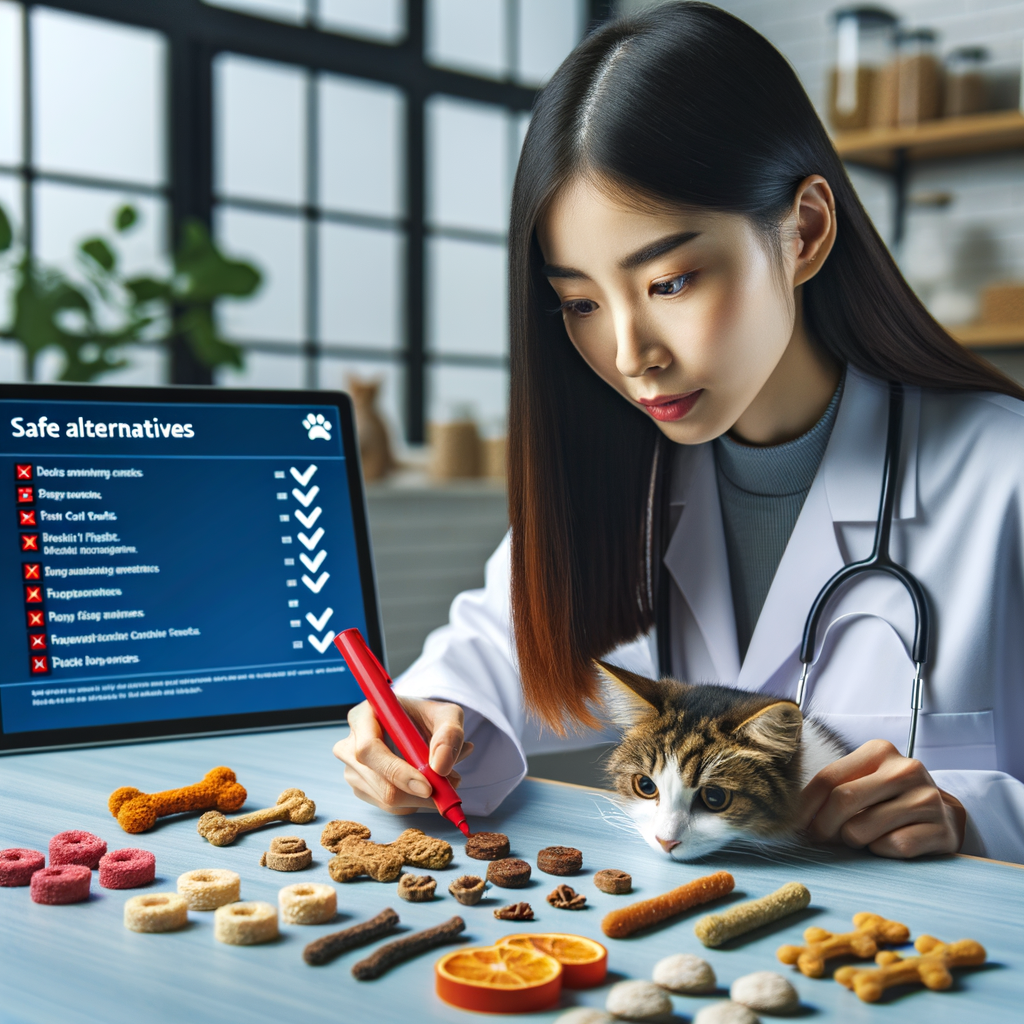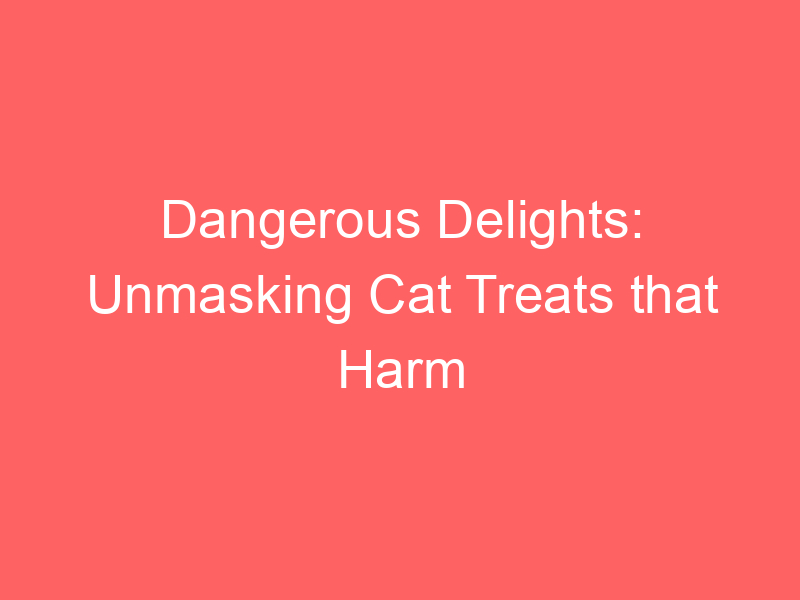
Introduction: The Risks of Cat Treats
As a cat owner, you want nothing but the best for your feline friend. This includes providing them with tasty treats that they can enjoy. However, it’s crucial to understand that not all cat treats are created equal. Some can pose significant risks to your cat’s health. In this article, we will delve into the safety concerns surrounding cat treats and the importance of identifying unsafe ones.
- Overview of Cat Treats Safety Concerns
- The Importance of Identifying Unsafe Cat Treats
While cat treats can be a great way to reward your cat or supplement their diet, some can be harmful. For instance, treats with high levels of sodium can lead to dehydration and kidney problems. Some treats also contain artificial colors and preservatives, which can cause allergic reactions or digestive issues. Furthermore, overfeeding treats can lead to obesity, a common health issue among domestic cats.
Identifying unsafe cat treats is crucial to protect your cat’s health. Unsafe treats can cause immediate health problems like vomiting or diarrhea, and long-term issues such as obesity and chronic diseases. Therefore, it’s essential to read the ingredients list before buying any treat. Avoid treats with high salt content, artificial colors, and preservatives. Also, remember that treats should not make up more than 10% of your cat’s daily caloric intake.
In the following sections, we will provide more detailed information about the good and bad types of cat treats, treats to avoid, and safe alternatives. By being informed, you can ensure your cat enjoys their treats without compromising their health.
Understanding Cat Treats: The Good and The Bad
As a cat owner, it’s important to know what goes into your furry friend’s treats. Not all treats are created equal, and some can even be harmful to your cat’s health. Let’s delve into what makes a cat treat unsafe.
What Makes a Cat Treat Unsafe?
There are two main factors that can make a cat treat unsafe: the ingredients it contains and how these ingredients affect your cat’s health.
- Common ingredients in harmful cat treats
- How these ingredients affect your cat’s health
Many cat treats on the market contain ingredients that can be harmful to your cat. These include artificial colors and flavors, preservatives, and fillers like corn and wheat gluten. These ingredients may make the treats look and taste more appealing, but they offer no nutritional value and can even cause health problems in cats.
Artificial colors and flavors can cause allergic reactions in some cats, leading to skin irritations and digestive issues. Preservatives, while necessary to keep the treats fresh, can build up in your cat’s system over time and lead to long-term health problems like kidney disease. Fillers, on the other hand, can cause weight gain and other health issues related to poor nutrition.
As a responsible cat owner, it’s important to read the ingredient labels on your cat’s treats and understand what each ingredient does. This will help you make informed decisions about what treats are safe for your cat to eat.
Identifying Unsafe Cat Treats
When it comes to ensuring the health and safety of your feline friend, it’s crucial to know how to identify potentially harmful cat treats. This involves two key steps: understanding ingredient labels and recognizing misleading marketing tactics.
- Reading and Understanding Ingredient Labels
Ingredient labels can often seem like a confusing jumble of scientific terms and numbers. However, with a little bit of knowledge, you can learn to decipher them and make informed decisions about the treats you give your cat.
Firstly, ingredients are listed in order of weight. This means that the first few ingredients make up the majority of the treat. If the first ingredient is a meat or fish product, that’s a good sign. However, if the first ingredient is a grain or filler like corn or wheat, it’s best to avoid that treat. Cats are carnivores and need a diet high in protein.
Secondly, be wary of ingredients with long, complicated names. These are often artificial additives or preservatives, which can be harmful to your cat’s health. A good rule of thumb is: if you can’t pronounce it, your cat probably shouldn’t eat it.
- Recognizing Misleading Marketing Tactics
Unfortunately, not all cat treat manufacturers have your pet’s best interests at heart. Some use misleading marketing tactics to make their products seem healthier than they really are.
For example, a treat might be labeled as “natural” or “organic”, but this doesn’t necessarily mean it’s healthy. These terms are not regulated in the pet food industry, so they can be used freely by manufacturers. Always check the ingredient list to see what’s really in the treat.
Another common tactic is to highlight a healthy ingredient on the packaging, like salmon or chicken. However, this ingredient might only make up a small percentage of the treat, with the rest being fillers and additives. Again, always check the ingredient list to get the full picture.
By learning to read ingredient labels and recognize misleading marketing tactics, you can ensure that the treats you give your cat are safe and healthy.
Dangerous Cat Indulgences: Treats to Avoid
As cat owners, we all want to spoil our furry friends once in a while. However, it’s crucial to be aware that not all treats are safe for our beloved pets. Some can pose severe health risks. In this section, we’ll discuss some specific brands and products that can be harmful to your cat and share a case study that highlights the effects of unhealthy cat treats.
- Specific brands and products that pose health risks
- Case study: The effects of unhealthy cat treats
Unfortunately, some cat treat brands use ingredients that can be harmful to your cat’s health. For instance, some products contain artificial colors and preservatives, which can lead to allergic reactions and digestive issues. Other treats may have high levels of sodium and sugar, which can contribute to obesity and diabetes. Brands such as ‘Treats Galore’ and ‘Feline Feast’ have been reported to contain these harmful ingredients.
Let’s look at a case study to understand the impact of unhealthy treats on a cat’s health. ‘Fluffy’, a 5-year-old domestic shorthair, was regularly given ‘Treats Galore’ by her owner. Over time, Fluffy started showing signs of lethargy and loss of appetite. Upon visiting the vet, it was discovered that Fluffy had developed diabetes, primarily due to the high sugar content in her treats. This case serves as a stark reminder of the potential dangers of unhealthy cat treats.
It’s essential to read the ingredients list before purchasing cat treats. Avoid products with artificial colors, preservatives, and high levels of sodium and sugar. Remember, your cat’s health should always be the top priority.
| Brand | Problematic Ingredients |
|---|---|
| Treats Galore | Artificial colors, High sugar content |
| Feline Feast | Artificial preservatives, High sodium content |
In conclusion, while it’s tempting to spoil our cats with treats, it’s crucial to ensure that these indulgences don’t harm their health. Always choose treats that are made with natural ingredients and are low in sugar and sodium.
Safe Alternatives for Cat Treats
While it’s important to be aware of the risks associated with certain cat treats, it’s equally important to know that there are safe alternatives available. One of the best ways to ensure your cat’s safety while indulging their taste buds is by offering them homemade cat treats.
Homemade Cat Treats
Homemade cat treats are a fantastic way to control what goes into your cat’s diet. They are easy to make and can be tailored to your cat’s specific dietary needs and preferences.
- Benefits of homemade cat treats
- Easy and healthy recipes to try
There are several benefits to making your own cat treats at home. Firstly, you have complete control over the ingredients used, which means you can avoid harmful additives and preservatives often found in store-bought treats. Secondly, homemade treats can be a cost-effective alternative to expensive commercial products. Lastly, making treats at home can be a fun and rewarding experience for both you and your cat.
There are many simple and healthy cat treat recipes you can try at home. For instance, you can make a basic cat treat with just three ingredients: canned tuna, catnip, and egg. Simply blend these ingredients together, shape them into small bite-sized pieces, and bake in the oven until crispy. Another easy recipe involves mixing canned salmon, whole wheat flour, dried catnip, and beaten egg to create a dough, which can then be cut into fun shapes and baked. Remember, always consult with your vet before introducing new foods into your cat’s diet.
By making your own cat treats, you can ensure your feline friend is getting a safe, healthy, and delicious reward. Plus, it’s a great way to show your cat some extra love and care.
Store-Bought Safe Cat Treats
While homemade cat treats are a great option, there are also a number of store-bought treats that prioritize your cat’s health. These treats are carefully formulated to provide your cat with the nutrients they need, while also being delicious and enjoyable for them.
- Brands that prioritize cat health
- What to look for when buying cat treats
- Natural ingredients: Look for treats made with real meat, fruits, and vegetables.
- No artificial additives: Avoid treats with artificial colors, flavors, or preservatives.
- Nutritional balance: Treats should not replace a balanced diet. Look for treats that complement your cat’s regular food.
- Size and texture: Choose treats that are appropriate for your cat’s size and chewing capabilities.
There are several brands that are known for their commitment to cat health. These include:
| Brand | Key Features |
|---|---|
| Purina | Offers a wide range of treats with different flavors and textures, all made with high-quality ingredients. |
| Blue Buffalo | Known for their natural ingredients and grain-free options. |
| Greenies | Specializes in dental treats that help maintain your cat’s oral health. |
Remember, the best brand for your cat will depend on their specific needs and preferences.
When buying cat treats, there are several things you should look for:
By choosing treats with these features, you can ensure that your cat is getting a tasty reward that also contributes to their overall health.
Conclusion: Ensuring Your Cat’s Safety
As we wrap up this informative journey about cat treats, we hope that you now have a better understanding of the potential health risks and safe alternatives. Let’s summarize the key points we’ve discussed.
- Key takeaways on cat treats health risks:
- Final thoughts on safe alternatives for cat treats:
Cat treats, while enjoyable for our feline friends, can pose significant health risks if not chosen carefully. Many commercial treats are packed with unhealthy ingredients such as artificial preservatives, colorings, and high levels of sodium and sugar. These can lead to obesity, dental problems, and even severe health conditions like kidney disease. Remember, treats should make up no more than 10% of your cat’s daily caloric intake.
There are plenty of safe alternatives to commercial cat treats. Homemade treats made from fresh meat, fish, or vegetables can be a healthy option. Other safe alternatives include catnip, dental chews, and freeze-dried protein treats. Always consult with your vet before introducing a new treat into your cat’s diet.
In conclusion, it’s crucial to be mindful of what we’re feeding our cats. Their health and safety are in our hands. By making informed choices about their treats, we can ensure they live a long, happy, and healthy life.








